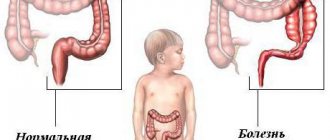Features of appearance
In children, the development of the disease in most cases is triggered by an infection that enters the tissue. This may be due to the following factors:
- Deep caries. The density of baby teeth is much lower than permanent teeth, and therefore even minimal caries can quickly lead to infection penetrating deep into the tissue.
- Babies often taste various objects, which leads to damage to the mucous membranes of the gums. If there are pathogenic microorganisms in the injured area, there is a high probability of developing periostitis.
- Children between the ages of 2 and 4 often cannot brush their teeth or maintain oral hygiene properly. Food elements and plaque can collect in the gum pockets, which often leads to inflammation.
- In some cases, the cause of periostitis is tooth extraction and infection in the oral cavity. Pathogenic microorganisms gain access to the gums through the wound and, as a result of insufficiently strong immunity, provoke the development of serious inflammation.
- In rare cases, flux develops as a complication of inflammation in other areas. Everything is due to the fact that the infection is transmitted through the blood to the periosteal tissue.
What is the danger of flux in young children?
Some parents believe that baby teeth do not need to be treated, associating this with the fact that they will soon fall out anyway. As a result, dentists are faced with an advanced form when flux occurs in preschool children. Milk teeth are especially susceptible to carious lesions, which provoke the appearance of periostitis.
In addition, refusal of treatment can lead to serious complications: the infection can spread to the root molar or internal organs of the child. Some children experience acute purulent periostitis, which occurs with severe deterioration and requires urgent medical attention.
Untreated gumboil can lead to tooth loss
Other possible complications include adentia and phlegmon. With flux, the inflammatory process spreads in the bone tissue, which destroys the rudiments of permanent molars and increases the likelihood that they will not grow in this place.
It is not difficult to suspect the development of complications. As a rule, during treatment, after opening the flux, the symptoms begin to rapidly disappear: after a few hours, the temperature drops and swelling disappears. If symptoms persist and the child's condition worsens, there is a high chance that complications have developed.
Typical signs and manifestations
During the first days after the onset of inflammation, children complain of pain in the mouth. Minimal swelling of the gums appears. Children under the age of 3 usually begin to be capricious and do not want to eat. Often parents do not notice this stage of the disease, and the first signs are explained by the fact that the child is simply behaving badly.
Gradually the situation is getting worse. Throbbing pain and a purulent lesion on the gum appear. The active development of the inflammatory process leads to the appearance of significant swelling of the soft facial tissues. In the case of periostitis in the upper jaw, swelling is observed on the cheek, as well as near the eyes and ears. If inflammation occurs in the lower jaw, swelling may also appear in the neck area. The child’s general well-being noticeably worsens, the body temperature rises significantly, the child complains of malaise and poor appetite.
What is flux
Flux in a child is a bacterial inflammation of the upper layer of the alveolar process or the entire jaw bone. The alveolar process is most often affected on the buccal side rather than on the palatal or lingual side. In 86% of cases, a purulent tumor forms near the baby teeth of the lower jaw. On the gum of the upper jaw, periostitis rarely develops.
As a rule, gumboil flux occurs near the molar premolars, less often - near the incisors and canines. The disease is acute with pronounced signs of the inflammatory process.
Causes of periostitis of the jaw
The causes of gumboil in a child can be:
- poor-quality teeth cleaning, in which a large amount of bacterial plaque accumulates on the cervical area of the teeth;
- mechanical injury to the gums from toys and other foreign objects;
- caries of primary teeth and its complications;
- infectious diseases of the throat and oral cavity;
- hypothermia of the body;
- stress;
- decreased general immunity.
Often, gumboil in children is the result of untreated periodontitis. Streptococci, staphylococci, putrefactive bacteria and various types of bacilli penetrate the bone tissue and cause the accumulation of purulent exudate, as a result of which flux develops.
Symptoms of gumboil in children
Flux on the gums of a child has the following symptoms:
- redness of the gums near one baby tooth;
- swelling of the mucous membrane of the alveolar process;
- the appearance of a dense lump on the gum fold;
- pain aggravated by heat and relieved by cold;
- discharge of pus under the mucous membrane or into the oral cavity;
- bad breath;
- change in facial configuration;
- increase in body temperature up to 38 degrees;
- deterioration in the child’s general well-being;
- loss of appetite;
- enlargement of regional lymph nodes.
Photo of flux in a child
You can see what gumboil looks like on a child’s gums in the photo.
A compaction filled with purulent contents is clearly visible near the tooth. This neoplasm is a distinctive feature of periostitis from other inflammatory diseases of the periodontium and periosteum.
Complications
Many parents do not understand how serious a problem periostitis can become. In some cases, complications develop that can even pose a threat to the child’s life. Let's look at some complications:
- An abscess is the appearance of a large abscess that extends beyond the boundaries of the periosteum. Purulent foci can come out in the cheek or gum area. They may constantly leak pus.
- Damage to the rudiments of molars, which can even lead to their death. It all ends with the fact that after baby teeth fall out, permanent ones do not erupt in their place, as a result of which one has to resort to installing dentures in their youth.
- Phlegmon is damage to neighboring areas by an inflammatory process with the release of pus. This is the most serious consequence of periostitis, which often leads to blood poisoning, which is associated with a high probability of death.
Complications of dental periostitis
If flux is ignored for a long time, a child may develop serious complications in the form of:
- chronic gum disease;
- spread of pus deep into the bone tissue;
- acute osteomyelitis;
- abscess;
- phlegmon.
Timely treatment of flux in a child results in complete recovery. After 5 days, pain and other unpleasant symptoms of inflammation are eliminated, the growth heals and the general condition of the body improves.
Treatment methods
In any case, the fight against flux should be carried out under the supervision of a specialist. The choice of treatment method depends on the age category of the child. Doctors often recommend surgical intervention, during which the surgeon opens the flux, cleanses the tissues of pus and ensures proper drainage of the formed cavity. This solution relieves the child of acute pain and helps avoid recurrence of the problem.
It should be understood that surgery is only one component of treatment. After a visit to a specialist, parents need to perform treatment procedures at home. In particular, it is important to take an antibiotic, which is chosen by a doctor, rinse your mouth with special antiseptics and use traditional medicine methods.
Treatment
Treatment of flux in children should be carried out strictly under the supervision of a doctor. At the same time, treatment tactics for a one-year-old baby and a 7-year-old child may differ due to the fact that before the natural change of the primary bite, it is possible to remove a temporary tooth, which is extremely undesirable before the age of 5-6 years.
In such cases, it is rarely possible to do without surgery. Quite often it is necessary to resort to a surgical method of treatment - opening the flux with complete removal of all purulent masses and drainage of the resulting cavity. This allows you to both relieve acute pain and prevent the re-formation of gumboil.
But surgical treatment is one of the stages of therapy. After visiting the dentist, the child’s parents should continue treatment at home, which will include taking an antibiotic prescribed by a doctor, rinsing the mouth with antiseptic solutions and using traditional medicine.
Treatment at home
In the first few days after visiting the dentist, when pain may still bother the baby, it is necessary to take anti-inflammatory drugs (paracetamol, ibufen), which help both relieve pain and help the inflammatory process subside as quickly as possible.
An important point in home treatment is the use of antiseptic solutions for treating the oral cavity. The dentist will tell you what exactly to rinse the child’s mouth with, but we will only present possible treatment options that can be used even in a small child.
- Aqueous solution of chlorhexidine. A ready-made pharmaceutical preparation is used, which is used to rinse the mouth 3-4 times a day (after meals and before bedtime). It has a powerful antiseptic effect, but does not irritate the mucous membranes of the mouth.
- Furacillin solution. You can prepare it at home (1 tablet per 0.5 liters of water) or buy a ready-made product. Rinse your mouth up to 5 times a day (it is advisable to do this after eating).
- Miramistin is destructive to microorganisms and relieves inflammation well. It is recommended to rinse your mouth with 10 ml of solution 3-4 times a day. However, the drug cannot be used before the age of three.
A child should rinse his mouth with any of the above products strictly under the supervision of adults in order to avoid accidents. The course of treatment should continue until all manifestations completely subside and the purulent cavity heals.
Treatment with folk remedies
Traditional medicine recipes complement traditional treatment well. However, you need to be careful with such methods in very young children, and for treating children under 2 years of age it is better not to use them at all.
- Soda solution. This remedy has a good anti-inflammatory effect. A teaspoon of dry baking soda powder is dissolved in a large cup of warm boiled water and allowed to rinse the child’s mouth 3-4 times a day after eating. The effect of treatment can be enhanced with iodine by adding a few drops to the rinse solution.
- Propolis tincture also perfectly relieves inflammation and has an antiseptic effect. To treat the oral cavity, dissolve 5 drops of tincture in 200 ml of warm water and rinse the mouth 2-3 times a day.
- Herbal decoctions. Medicinal plants such as chamomile, calendula, and string are natural antiseptics and quickly relieve even severe inflammation. They allow both to cure the disease itself and to prevent the development of its complications. Decoctions are prepared daily, for which 2 tablespoons of a mixture of herbs are infused in half a liter of boiling water. Rinse your mouth with the resulting decoctions 4-5 times a day until complete recovery.
Homeopathy treatment
Homeopathic medicines can also be used in addition to primary treatment. You cannot try to cure gumboil in a child using homeopathy alone, since such remedies only play a supporting role. All prescriptions should be made only by a homeopathic doctor.
Providing first aid for periostitis
When the first signs of gumboil appear, it is extremely important to promptly contact a professional dentist. If the trip takes some time, you need to take care of providing first aid to the baby:
- Anti-inflammatory drugs are used to relieve acute pain, fight inflammation and reduce temperature. For example, you can use paracetamol or ibufen.
- Swelling is relieved with the help of antihistamines (Parlazin, Suprastin, etc.). The dosage is selected according to the instructions, taking into account the age of the child.
- To relieve tissue swelling and reduce pain, use a cold compress, which is applied to the damaged area.
- Under no circumstances should you open a purulent formation on your own. Often such actions lead to aggravation of the situation, including blood poisoning and death.
- If the periostitis bursts without external intervention, do not squeeze out the pus that is inside. This can lead to serious negative consequences.
It is forbidden to use Vishnevsky ointment or heat the problem area, as this only contributes to a more active inflammatory process, which often leads to additional complications.
Preventive actions
You need to understand that periostitis, like many other childhood ailments, is better prevented. From an early age it is necessary to prevent inflammation of the oral cavity, which includes the following elements:
- regular scheduled dental examinations, as well as rehabilitation of minimal carious defects;
- carefully checking whether the child maintains proper oral hygiene;
- treatment of various infectious diseases in childhood;
- preventive actions prescribed by a specialist after the removal of baby teeth.
By following basic recommendations, you can ensure maximum protection against periostitis, as well as other inflammations in the oral cavity.
ATTENTION! Do not self-medicate. Be sure to show your child to a dentist.









